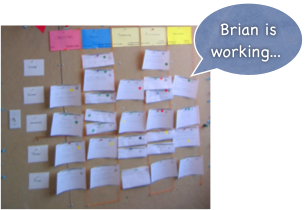Latour 3: Anthrax and standups
A transcript of an OOPSLA talk: Table of contents
Shift gears now to the daily standup. There’s a ritual: someone says what she did yesterday, what she plans to do today, and what impediments she sees in the team’s path. Good standups are crisp and motivating. A lot of standups are bad. They have the enervating effect of an hour-plus weekly status meeting, only spread out over a week.
Why is this? And what can be done about it?
To answer, I’ll start with the story of the anthrax bacillus from Latour’s The Pasteurization of France. At one point, there was a disease called “anthrax.” People understood the properties of this disease: they knew what symptoms it had, they knew that people could contract the disease from warm corpses but not from cold or rotten ones, and they knew that some “accursed” fields gave anthrax to any animal that grazed there.
Pasteur wanted to replace anthrax-the-disease with anthrax-a-bacillus. He undertook a fairly systematic programme:
-
Early on, he could induce the symptoms of anthrax by extracting icky stuff from a sick animal, diluting it fantastically, and then injecting a tiny bit of the dilute solution into a new animal. However: so? No one sneaks around at night injecting cows in fields.
-
So the next step is to induce anthrax by a more natural means. They tried feeding the animals hay laced with anthrax, but that didn’t give them the disease. However, a feed more representative of real life—feed containing prickly nettles—did. So there’s a realistic way animals can get the disease that’s directly traceable to the idea of injection.
-
What about the slaughterhouse workers and the safe corpses? Well, it turns out that anthrax forms spores to ride out harsh environments: like the cold, nasty environment of a dead animal. That’s a plausible explanation for what renderers know. One more bit of anthrax-the-disease can be explained in terms of anthrax-the-bacillus.
-
There’s even a reason for accursed fields. Suppose someone buries an animal dead of anthrax. You’ve basically buried a whole pile of spores. In dirt. That contains earthworms. One of the things that earthworms do is turn dirt over, moving dirt from down below to the surface. As a side-effect, they steadily replenish the surface with spores. Result: an accursed field, perhaps accursed well after the last person’s forgotten anything was buried there.
-
And, finally, you can do more with the bacillus than you can with the disease. In particular, you can make a vaccine.
At some point, anthrax-the-disease can be understood in terms of anthrax-the-bacillus. Roles switch: now if you want to say something about the disease, you have to be prepared to trace that statement back to the bacillus.
In the jargon, the bacillus has become an obligatory point of passage.
One of the things we’ve done in Agile is to make the frequent creation of running, tested, potentially shippable software into an obligatory point of passage. Teams that don’t produce potentially shippable software at the end of each iteration are likely in trouble. Moreover, team members ought to be able to trace what they’re doing to the goals of the release; if not, they ought to be prepared to question what they’re doing.
In order to understand and pace the work of the release, it’s convenient to break it down into smaller pieces, individual stories. The stories are also individual points of passage, just littler ones.
Dull standups often make no reference to visible stories. Either people don’t have a wall with stories on it, they don’t do the standup in front of that wall, or they don’t gesture at the wall while speaking. In ANTian terms, they’re demonstrating that the stories aren’t really obligatory points of passage. What to do about that?
Another trick of ANT’s is not to bother making a distinction between humans and other kinds of actors. So, when Kent Beck writes, in the introduction to Smalltalk Best-Practice Patterns, “If you’re programming along, and all of a sudden your program gets balky, makes things hard for you, it’s talking,” an ANT analysis wouldn’t report that with a side-comment like “Of course, programs don’t really get balky.” Lots of programmers talk as if code can push back, so why not take them at their word and see what comes of that?
 A while back, I was thinking along these lines when I realized that if the stories are so important to the project, they ought to be the ones speaking in the standup. I imagined a story card saying, “Brian’s going to keep working on me today, but he’s having trouble. He could use the help of someone who knows Hibernate.”
A while back, I was thinking along these lines when I realized that if the stories are so important to the project, they ought to be the ones speaking in the standup. I imagined a story card saying, “Brian’s going to keep working on me today, but he’s having trouble. He could use the help of someone who knows Hibernate.”
 Now, I never had the nerve to actually suggest that team members ought to hold the story cards like little mouths, open and close them, and pretend it was the stories talking, but while I was preparing for this talk, I had another thought. Yes, the stories can’t talk, but there’s no reason not to structure the standup around them. Instead of going around the people, you can step through all the stories in play. For each, someone can say what happened to that story yesterday, what’s to be done on it today, and whether there are any risks to its completion.
Now, I never had the nerve to actually suggest that team members ought to hold the story cards like little mouths, open and close them, and pretend it was the stories talking, but while I was preparing for this talk, I had another thought. Yes, the stories can’t talk, but there’s no reason not to structure the standup around them. Instead of going around the people, you can step through all the stories in play. For each, someone can say what happened to that story yesterday, what’s to be done on it today, and whether there are any risks to its completion.
I plan to recommend that clients give this a try. At least, it will cut out conversational deadeners like “I paired with Dawn and Karl, so I did the same thing they did” and “I can’t remember what I did.” [I’m also pleased that two people said they’d try it on their teams when they got home.]
So, there: another example of using a weirdo theory from sociologist to give myself ideas.
Story board from arbdesign.dk, woman with fish from Willem Velthoven.

November 9th, 2007 at 10:03 am
[…] Marick has posted the transcript of his OOPSLA talk in several parts. Part 3 discusses Pasteur’s attempts to educate the French about the causes of anthrax, and relates […]
November 15th, 2007 at 4:11 pm
I’ve introduced the idea of story-centric standups on a previous team that was struggling with Scrum, and was quite pleased with the result. It was a very political organization, and people were more concerned with proving that they had kept busy than in bringing visibility to roadblocks and our progress through the stories selected for the sprint. I think the wording of the 3 questions contributed to this problem. We almost always ended the sprint with a lot of stories “almost done” but very few “done done”.
When we started standing next to the story board during our stand-ups, and iterating through stories rather than iteratating through people, we got a much clearer picture of how we were doing and where we were running into problems. For the next few sprints (the last several sprints before the release) we were able to identify roadblocks and trouble spots a lot earlier, and as a result were able hit our iteration goals and ship in time.
I think this idea deserves more attention. I’d love to hear you results with this approach after you’ve had a chance to try it with a few clients.
October 27th, 2009 at 4:19 pm
[…] Marick sugeriu a abordagem da Teoria de Rede de Atores, que novamente é focada nas estórias. Nesse formato, ao invés de ficar ao redor das pessoas, as […]
February 17th, 2010 at 10:01 am
[…] releasing potentially shippable software Jump to Comments Brian Marick wrote a couple of years ago that “Teams that don’t produce potentially shippable software at the end of each iteration […]
April 7th, 2013 at 10:25 am
[…] – Brian Marick, "Latour 3: Anthrax and standups" […]